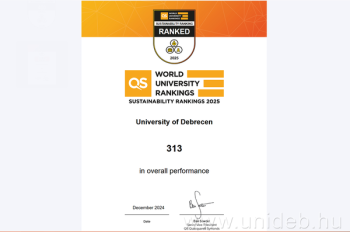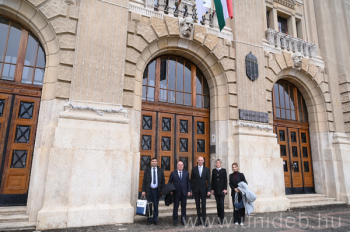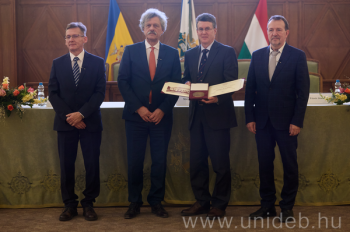At the Department of Neurosurgery of the University of Debrecen Clinical Centre intraoperative monitoring has been used for more than fifteen years. Recently, the procedure has been supplemented with pedicle screw stimulation for both dorsal and lumbar spine surgeries. This neuromonitoring system is used in spinal deformity surgery. Its aim is to detect abnormal changes in the functional integrity of the spinal cord during surgery and to reverse the process by the necessary surgical or anaesthetic intervention. The recently acquired Neurosoft IOM32 monitoring system at the Department of Neurosurgery allows the intervention to be performed more safely than ever before.
- In scoliosis surgery, we correct the curvature by inserting metal implants, screws and rods. It is very important that the screws are in the right position; otherwise the spinal cord can be damaged, which can cause lower limb paralysis. With the new electrophysiological method, we can control the position of the screws during surgery and intervene if necessary. By stimulating all the screws, both dorsally and lumbar, we can check their position, make sure that the implants are in the right place, that they are not too close to the spinal cord, for example, and that they do not cause neurological damage. So far, we have only been able to check this after the operation, when the patient wakes up," said Péter Ruszthi, Senior Physician of the Department of Neurosurgery at the University of Debrecen Clinical Centre.
The new procedure is also significant for the Department of Neurosurgery because the institution plays a role in scoliosis surgery nationwide.
- We not only correct scoliosis in children, but also treat a large number of adult deformities. Electrophysiological monitoring has long been used in the department to monitor different functions for different types of surgery. For more than 15 years, Professor Dezső Jeszenszky has been giving master classes here two or three times a year, where we can perfect the technique. The surgery of spinal deformities has developed a great deal in the last decades, which inevitably brings with it the need to improve monitoring techniques," adds László Novák, Associate Professor and Director of the Department of Neurosurgery.
In order for the operating team to get reliable indications of the patient's condition, the anaesthesia method, the quantity and quality of anaesthetics, the depth of anaesthesia, among other things, are very important, and the anaesthetist is responsible for these. Béla Tankó, assistant professor of anaesthesiology, learned the process of electrophysiological monitoring at the Schulthess Klinik in Zurich, Europe's most famous spinal surgery centre, where a very high quality intraoperative electrophysiology team is led by Martin Sutter.
- It was important for me to learn this method, and I received a great deal of help from the Department of Neurology, from specialist Klára Fekete. I have been studying for two years, first in Hungary and then I went on a one-month study trip to Switzerland, one of the best orthopaedic clinics in Europe. Currently, two anaesthesia specialists are part of the surgical team, one of them is in charge of anaesthesia and the other one monitors and controls the electrophysiological signals. If a problem is detected based on the electrophysiological signals, we report it to the surgeon, who can intervene immediately," Béla Tankó, assistant professor at the Department of Anaesthesiology and Intensive Care, told hirek.unideb.hu.
The Department of Anaesthesiology and Intensive Care attaches great importance to state-of-the-art patient tracking during surgery for patient safety.
- We believe it is important to learn and implement all state-of-the-art procedures to reduce complications for patients during and after surgery. In the last decade and a half, such methods have included the introduction of ultrasound-guided local anaesthesia techniques in thyroid and carotid surgery, but this is also the aim of the operating room monitor for tracking the effects of muscle relaxants, in the development of which our clinic has played a key role over the last decade," said Béla Fülesdi, Professor and Director of the Department of Anaesthesiology and Intensive Care.
The new procedure, which includes pedicle screw stimulation, has been routinely used for a month at the Department of Neurosurgery of the University of Debrecen Clinical Centre, where - as a nationally renowned institution - 2- 4 such operations are performed every week.
Press Office - CzA


